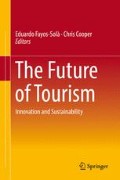Abstract
Competition among tourism destinations continues apace with their ability to be truly distinctive in the marketplace ever more difficult as so many now seek to position themselves as great places to visit, as well as great places to live, work and study. This chapter analyzes the issues concerning strategic positioning in tourism destinations and the need for destinations to re-position themselves when change takes place in their macro and micro-environments. Following an overview of the many generic challenges facing the marketing, branding and positioning of destinations, including the highly complex and turbulent macro environment and the ever-increasingly competitive micro environment, the chapter explores the opportunities and challenges faced by destinations seeking to re-position themselves in the marketplace. In the face of much stiffer competition, a changing and more turbulent world order, and major innovations in tourism products, services and experiences, it is clear that all destinations have a challenging future ahead. Following a comparison of the positioning and re-positioning of two major destinations in the US, namely Orlando and Las Vegas, the chapter concludes by providing the reader with some projections for the future positioning and re-positioning of destinations.
Access this chapter
Tax calculation will be finalised at checkout
Purchases are for personal use only
References
Avraham, E. (2016). Destination marketing and image repair during tourism crises: The case of Egypt. Journal of Hospitality and Tourism Management, 28, 41–48.
Avraham, E., & Ketter, E. (2008). Media strategies for marketing places in crises: Improving the image of cities, countries and tourist destinations. Oxford: Butterworth Heinemann.
Avraham, E., & Ketter, E. (2016). Marketing tourism for developing countries: Battling stereotypes and crises in Asia, Africa and the Middle East. London: Palgrave Macmillan.
Chacko, H. E., & Marcell, M. H. (2008). Repositioning a tourism destination: The case of New Orleans after hurricane Katrina. Journal of Travel & Tourism Marketing, 23(2–4), 223–235.
Dineen, C. (2015, August 15). Orlando overtakes Chicago as nation’s top meeting destination. Retrieved from http://www.orlandosentinel.com/business/tourism/os-rlando-cvent-ranking-20150814-story.html
Dinnie, K., Melewar, T. C., Seidenfuss, K. U., & Musa, G. (2010). Nation branding and integrated marketing communications: An ASEAN perspective. International Marketing Review, 27(4), 388–403.
Edgell, D. (2016). Correspondence on TriNet. East Carolina University.
Fyall, A. (2011). Destination management: Challenges and opportunities. In Y. Wang & A. Pizam (Eds.), Destination marketing and management: Theories and applications (pp. 340–357). Oxford: CABI.
Insch, A., & Bowden, B. (2016). Possibilities and limits of brand repositioning for a second-ranked city: The case of Brisbane, Australia’s “New World City”, 1979–2013. Cities, 56, 47–54.
Knott, B., Fyall, A., & Jones, I. (2013). The nation-branding legacy of the 2010 FIFA World Cup for South Africa. Journal of Hospitality Marketing & Management, 22(6), 569–595.
Kotler, P., Bowen, J. T., & Makens, J. C. (2005). Marketing for hospitality and tourism. Upper Saddle River, NJ: Pearson.
Kozak, M., & Martin, D. (2012). Tourism life cycle and sustainability analysis: Profit-focused strategies for mature destinations. Tourism Management, 33, 188–194.
Kresic, D. (2007). Tourism destination attractiveness factors in the function of competitiveness. Acta Turistica, 19(1), 1–100.
Lewis, R. C., Chambers, R. E., & Chacko, H. E. (1995). Marketing leadership in hospitality. New York: Van Nostrand Reinhold.
Minghetti, V. (2001). From destination to destination marketing and management: Designing and repositioning tourism products. International Journal of Tourism Research, 3, 253–259.
Nemec-Rudez, H., Sedmak, G., Vodeb, K., & Bojnec, S. (2014). Visitor structure as a basis for destination repositioning – The case of a north Mediterranean destination. Annales: Series Historia et Sociologia, 24, 53–66.
Oehmichen, A. (2012). Repositioning a destination: A case study of Montenegro. London: HVS.
Pike, S., & Ryan, C. (2004). Destination positioning analysis through a comparison of cognitive, effective, and conative perceptions. Journal of Travel Research, 42, 333–342.
Plog, S. (2001). Why destination areas rise and fall in popularity. Cornell Hotel and Restaurant Administration Quarterly, 42(3), 3–13.
Pride, R. (2016, July). Personal communication. University of Surrey.
Ro, H., Lee, S., & Mattila, A. (2013). An affect image position of Las Vegas hotels. Journal of Quality Assurance in Hospitality & Tourism, 14, 201–217.
Sharpley, R., & Telfer, D. (2015). Tourism and development: Concepts and issues (2nd ed.). Bristol: Channel View Publications.
Skift. (2016). The state of global travel 2016. Retrieved from https://trends.skift.com/trend/state-global-travel-2016/
Srinivas, R. (2015, April 9). Orlando: Most visited tourist destination in the US 62 million people visited in 2014. Retrieved from http://www.inquisitr.com/1995019/orlando-most-visited-tourist-destination-in-the-u-s-62-million-people-visited-the-city-in-2014/
Tkaczynski, A., Hastings, K., & Beaumont, N. (2006, December 4–6). Factors influencing repositioning of a tourism destination. In Y. Ali & M. van Dessel (Eds.), ANZMAC 2006 conference proceedings: Advancing theory, maintaining relevance. Brisbane, QLD: School of Advertising, Marketing and Public Relations, Queensland University of Technology.
Van den Berg, L., Braun, E., & van Winden, W. (2001). Growth clusters in European cities: An integral approach. Urban Studies, 38(1), 185–205.
Author information
Authors and Affiliations
Corresponding author
Editor information
Editors and Affiliations
Rights and permissions
Copyright information
© 2019 Springer International Publishing AG, part of Springer Nature
About this chapter
Cite this chapter
Fyall, A. (2019). Tourism Destination Re-positioning and Strategies. In: Fayos-Solà, E., Cooper, C. (eds) The Future of Tourism. Springer, Cham. https://doi.org/10.1007/978-3-319-89941-1_14
Download citation
DOI: https://doi.org/10.1007/978-3-319-89941-1_14
Published:
Publisher Name: Springer, Cham
Print ISBN: 978-3-319-89940-4
Online ISBN: 978-3-319-89941-1
eBook Packages: Business and ManagementBusiness and Management (R0)

